
Uniforms of the Confederate States military forces
Encyclopedia

Uniform
A uniform is a set of standard clothing worn by members of an organization while participating in that organization's activity. Modern uniforms are worn by armed forces and paramilitary organizations such as police, emergency services, security guards, in some workplaces and schools and by inmates...
s used by the Confederate Army
Confederate States Army
The Confederate States Army was the army of the Confederate States of America while the Confederacy existed during the American Civil War. On February 8, 1861, delegates from the seven Deep South states which had already declared their secession from the United States of America adopted the...
and Navy
Confederate States Navy
The Confederate States Navy was the naval branch of the Confederate States armed forces established by an act of the Confederate Congress on February 21, 1861. It was responsible for Confederate naval operations during the American Civil War...
during the American Civil War
American Civil War
The American Civil War was a civil war fought in the United States of America. In response to the election of Abraham Lincoln as President of the United States, 11 southern slave states declared their secession from the United States and formed the Confederate States of America ; the other 25...
, from 1861 to 1865. The uniform varied greatly due to a variety of reasons, such as location, limitations on the supply of cloth and other materials, and the cost of materials during the war.
Confederate forces were often poorly supplied with uniforms, especially late in the conflict. Servicemen sometimes wore combinations of uniform pieces, also wearing captured Union
Union Army
The Union Army was the land force that fought for the Union during the American Civil War. It was also known as the Federal Army, the U.S. Army, the Northern Army and the National Army...
uniforms, and items of personal clothing. They sometimes went without shoes altogether, and broad felt or straw hat
Straw hat
A straw hat is a brimmed hat that is woven out of straw or reeds. The hat is designed to protect the head from the sun and against heatstroke, but straw hats were also used in fashion and as a decorative element of a uniform.- Manufacture :...
s were worn as often as kepi
Kepi
The kepi is a cap with a flat circular top and a visor or peak . Etymologically, the word is a borrowing of the French képi, itself a respelling of the Alemannic Käppi: a diminutive form of Kappe, meaning "cap"....
s or naval caps. There are some controversies about some of the exact details of a few of the uniforms, since some of the records were lost or destroyed after the Civil War
American Civil War
The American Civil War was a civil war fought in the United States of America. In response to the election of Abraham Lincoln as President of the United States, 11 southern slave states declared their secession from the United States and formed the Confederate States of America ; the other 25...
ended.
Overview
The original Confederate uniforms from all branches of the military closely followed the lines of the Union’s uniformsUniform of the Union Army
The Uniform of the Union Army was widely varied and, due to limitations on supply of wool and other materials, based on availability and cost of materials during the United States Civil War.- Generalization :The standard U.S...
. This was until 6 June, 1861 when the Confederate Council issued General Order 9 which was the new regulations for the Confederate Infantry, Cavalry and Artillery.
The new uniforms were designed by Nicola Marshall, a Prussian who was heavily influenced by the mid-1800's uniforms of the Austrian and French armies.
Although the regular Confederate military had a paper strength of 6,000 personnel, the first 100,000 volunteers from all over the South participated in a variety of dress. Many were from State Militia outfits which had their own State issued uniforms and in the early battles some Confederate units who wore dark blue outfits were often mistaken at the field of battle for the enemy, conversely, many Union units too which were originally militia
Militia
The term militia is commonly used today to refer to a military force composed of ordinary citizens to provide defense, emergency law enforcement, or paramilitary service, in times of emergency without being paid a regular salary or committed to a fixed term of service. It is a polyseme with...
units went to war wearing grey.
It was not until the Depot system was established in 1862 by the Confederate Quartermaster in Richmond Virginia that uniforms would be mass produced and supplied to troops. Until that time the "commutation system" was in place which allowed soldiers to have their own uniforms made to the new CSA regulations to be reimbursed by the CS government. Allowance was $21 per 6 months for uniforms.
Officers always had to buy their own until March 6, 1864 when General Order 28 was released which allowed Confederate officers to purchase uniforms from the same sources as the troops, and at cost price.
Following the Richmond Depot
Richmond Depot
The Richmond Depot is a Confederate-issued shell jacket to troops in the Army of Northern Virginia during the American Civil War.-History:Richmond Depot jackets were not issued to western Confederates or the Army of Tennessee.-Design:...
, other depots started up throughout the South to supply to their respective regional forces. Major depots were Columbus, Athens and Atlanta, Georgia for the Army of Tennessee
Army of Tennessee
The Army of Tennessee was the principal Confederate army operating between the Appalachian Mountains and the Mississippi River during the American Civil War. It was formed in late 1862 and fought until the end of the war in 1865, participating in most of the significant battles in the Western Theater...
and Houston, Texas and Shreveport, Louisiana for the Trans-Mississippi
Trans-Mississippi
The Trans-Mississippi was the geographic area west of the Mississippi River during the 19th century, containing the states of Arkansas, Louisiana, Missouri and Texas, and the Indian Territory . The term was especially used by the Confederate States of America as the designation for the theater of...
forces. The use of the depot system meant that Army wide uniformity was impossible, as different depots had unique uniform (Columbus Depot Jackets for instance, had breast pockets, whilst Richmond Depot Jackets did not). This resulted in a varied set of uniforms worn by different Confederate units.
As the war progressed the image began to shift from the "ragged rebel" look to a well-uniformed Army in the Eastern and Western theaters. In the last 12 months of fighting these Confederate forces were well uniformed, the best they had ever appeared in terms of consistency, wearing clothing made of imported blue-grey cloth, used by the British Army and manufactured in Limerick Ireland, by Peter Tait
Peter Tait
Sir Peter L. Tait was a New Zealand National Party Member of Parliament, Napier mayor, small businessman and opponent of New Zealand's Homosexual Law Reform Act.-Early life:...
specifically for the Confederacy.
Unfortunately in the Trans-Mississippi, problems of distribution of the plentiful uniforms made in Houston and Shreveport, meant that the South Western forces missed out. Many Trans-Mississippi troops were still wearing Federal uniforms until 1864, which were obtained from stock issued from a Federal depot in San Antonio that had been captured in 1861.
Confederate headgear was to be the chasseur
Chasseur
Chasseur [sha-sur; Fr. sha-sœr] is the designation given to certain regiments of French light infantry or light cavalry troops, trained for rapid action.-History:...
cap or "kepi", a French military cap. These were not popular due to their inability to protect the wearer from the sun, and regular civilian hats, slouch hat
Slouch hat
A slouch hat is a wide-brimmed felt or cloth hat with a chinstrap, most commonly worn as part of a military uniform. It is a survivor of the felt hats worn by certain 18th century armies. Since then, the slouch hat has been worn by military personnel from many nations including Australia, Britain,...
s, or other hats were often worn in the field instead. Confederate Cavalry troops often wore Hardee hat
Hardee hat
The Hardee hat, also known as the Model 1858 Dress Hat and sometimes nicknamed the "Jeff Davis", was the regulation dress hat for enlisted men in the Union Army during the American Civil War. The Hardee hat was also worn by Confederate soldiers. However, most soldiers found the black felt hat to...
s, much like the Union Cavalry which was a representative of the additional "flair" associated with the Cavalry troops. Two examples of CSA Cavalry officer's famous for wearing these hats are Colonel John S. Mosby
John S. Mosby
John Singleton Mosby , nicknamed the "Gray Ghost", was a Confederate cavalry battalion commander in the American Civil War...
and General J.E.B. Stuart
J.E.B. Stuart
James Ewell Brown "Jeb" Stuart was a U.S. Army officer from Virginia and a Confederate States Army general during the American Civil War. He was known to his friends as "Jeb", from the initials of his given names. Stuart was a cavalry commander known for his mastery of reconnaissance and the use...
.
| CSA Infantry Confederate States Army The Confederate States Army was the army of the Confederate States of America while the Confederacy existed during the American Civil War. On February 8, 1861, delegates from the seven Deep South states which had already declared their secession from the United States of America adopted the... |
CSA Navy Confederate States Navy The Confederate States Navy was the naval branch of the Confederate States armed forces established by an act of the Confederate Congress on February 21, 1861. It was responsible for Confederate naval operations during the American Civil War... |
CSA Cavalry Confederate States Army The Confederate States Army was the army of the Confederate States of America while the Confederacy existed during the American Civil War. On February 8, 1861, delegates from the seven Deep South states which had already declared their secession from the United States of America adopted the... |
CSA Artillery Field artillery in the American Civil War Field artillery in the American Civil War refers to the important artillery weapons, equipment, and practices used by the Artillery branch to support the infantry and cavalry forces in the field. It does not include siege artillery, use of artillery in fixed fortifications, or coastal or naval... |
|---|---|---|---|
 |
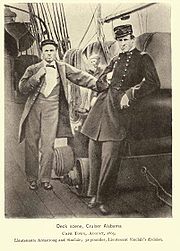 |
 |
Design
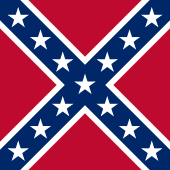
Southern United States
The Southern United States—commonly referred to as the American South, Dixie, or simply the South—constitutes a large distinctive area in the southeastern and south-central United States...
. This helped contribute to the fact that many Confederate soldiers suffered from heatstroke on long marches. Many Confederate soldiers started the war with Frock Coats. However, cloth shortages insured that by 1863,waist length gray or butternut jackets were universally worn by Confederates in the Eastern and Western Theater.
Grey was not the best choice for camouflage
Camouflage
Camouflage is a method of concealment that allows an otherwise visible animal, military vehicle, or other object to remain unnoticed, by blending with its environment. Examples include a leopard's spotted coat, the battledress of a modern soldier and a leaf-mimic butterfly...
, although at the time the usefulness of camouflage was not generally recognized. It was not until after the Spanish-American War
Spanish-American War
The Spanish–American War was a conflict in 1898 between Spain and the United States, effectively the result of American intervention in the ongoing Cuban War of Independence...
that the United States Army instituted a khaki
Khaki
This article is about the fabric. For the color, see Khaki . Kaki, another name for the persimmon, is often misspelled "Khaki".Khaki is a type of fabric or the color of such fabric...
uniform. Grey was chosen for Confederate uniforms because grey dye could be made relatively cheaply.
Generals
On the upright collar of full generals, lieutenant generals, major generals, and brigadier generals three stars were stitched within a wreath, all embroidered in gold coloring. The center star was slightly larger than the other stars. It was not possible to know which grade of general an officer was by their collar insignia. However, major generals and lieutenant generals wore three groups of buttons down the front of the overcoat, and brigadiers wore groups of two. At least 3 Generals officers did not wear the prescribed uniform: Robert E. Lee who wore the uniform of a Colonel, refusing to wear a generals insignia until the Confederate victory; Joseph L. HoggJoseph L. Hogg
Joseph Lewis Hogg was a politician and Confederate general from Texas. He was also the father of Texas Governor Jim Hogg....
, who died of a fever; and Benjamin McCulloch
Benjamin McCulloch
Benjamin McCulloch was a soldier in the Texas Revolution, a Texas Ranger, a U.S. marshal, and a brigadier general in the army of the Confederate States during the American Civil War.-Early life:...
.
Other officers
ColonelColonel
Colonel , abbreviated Col or COL, is a military rank of a senior commissioned officer. It or a corresponding rank exists in most armies and in many air forces; the naval equivalent rank is generally "Captain". It is also used in some police forces and other paramilitary rank structures...
s wore three gold stars of the same size on their collar; the same as generals, but without the wreath. While lieutenant colonel
Lieutenant colonel
Lieutenant colonel is a rank of commissioned officer in the armies and most marine forces and some air forces of the world, typically ranking above a major and below a colonel. The rank of lieutenant colonel is often shortened to simply "colonel" in conversation and in unofficial correspondence...
s wore two stars on their collars, major
Major
Major is a rank of commissioned officer, with corresponding ranks existing in almost every military in the world.When used unhyphenated, in conjunction with no other indicator of rank, the term refers to the rank just senior to that of an Army captain and just below the rank of lieutenant colonel. ...
s wore one star, which was placed in the middle of the collar. Captains had three gold horizontal bars, first lieutenant
First Lieutenant
First lieutenant is a military rank and, in some forces, an appointment.The rank of lieutenant has different meanings in different military formations , but the majority of cases it is common for it to be sub-divided into a senior and junior rank...
s wore two bars, and second lieutenant
Second Lieutenant
Second lieutenant is a junior commissioned officer military rank in many armed forces.- United Kingdom and Commonwealth :The rank second lieutenant was introduced throughout the British Army in 1871 to replace the rank of ensign , although it had long been used in the Royal Artillery, Royal...
s wore one bar. However, the Confederate Congress often created new commissions, and did not always standardize rank insignia immediately.
| Collar Insignias of the Confederate Army | ||||||
|---|---|---|---|---|---|---|
| General | Colonel Colonel Colonel , abbreviated Col or COL, is a military rank of a senior commissioned officer. It or a corresponding rank exists in most armies and in many air forces; the naval equivalent rank is generally "Captain". It is also used in some police forces and other paramilitary rank structures... |
Lieutenant Colonel Lieutenant colonel Lieutenant colonel is a rank of commissioned officer in the armies and most marine forces and some air forces of the world, typically ranking above a major and below a colonel. The rank of lieutenant colonel is often shortened to simply "colonel" in conversation and in unofficial correspondence... |
Major Major Major is a rank of commissioned officer, with corresponding ranks existing in almost every military in the world.When used unhyphenated, in conjunction with no other indicator of rank, the term refers to the rank just senior to that of an Army captain and just below the rank of lieutenant colonel. ... |
Captain | First Lieutenant First Lieutenant First lieutenant is a military rank and, in some forces, an appointment.The rank of lieutenant has different meanings in different military formations , but the majority of cases it is common for it to be sub-divided into a senior and junior rank... |
Second Lieutenant Second Lieutenant Second lieutenant is a junior commissioned officer military rank in many armed forces.- United Kingdom and Commonwealth :The rank second lieutenant was introduced throughout the British Army in 1871 to replace the rank of ensign , although it had long been used in the Royal Artillery, Royal... |
 |
 |
 |
 |
 |
 |
 |
Chevrons
Chevrons in the Confederate Army were only worn by sergeantSergeant
Sergeant is a rank used in some form by most militaries, police forces, and other uniformed organizations around the world. Its origins are the Latin serviens, "one who serves", through the French term Sergent....
s and corporal
Corporal
Corporal is a rank in use in some form by most militaries and by some police forces or other uniformed organizations. It is usually equivalent to NATO Rank Code OR-4....
s. Sergeants wore three chevrons on their sleeves, and corporals wore two chevrons.
| Chevrons of the Confederate Military | |||
|---|---|---|---|
| Sergeant Major Sergeant Major Sergeants major is a senior non-commissioned rank or appointment in many militaries around the world. In Commonwealth countries, Sergeants Major are usually appointments held by senior non-commissioned officers or warrant officers... |
Quartermaster Sergeant Quartermaster Sergeant Quartermaster Sergeant is a class of rank or appointment in some armed forces, especially those of the United Kingdom and the Commonwealth.-Ireland:Quartermaster Sergeant appointments in the Irish Defence Forces include:... |
Ordnance Sergeant Ordnance Sergeant Ordnance Sergeant was an enlisted rank in the U.S. and Confederate armies during the American Civil War era. The Ordnance Sergeant ranks just above a First Sergeant, yet below a Quartermaster Sergeant. The rank insignia consists of three inverted chevrons with a 5-pointed star above it.According... |
First Sergeant First Sergeant First sergeant is the name of a military rank used in many countries, typically a senior non-commissioned officer.-Singapore:First Sergeant is a Specialist in the Singapore Armed Forces. First Sergeants are the most senior of the junior Specialists, ranking above Second Sergeants, and below Staff... |
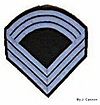 |
 |
 |
 |
| Sergeant Sergeant Sergeant is a rank used in some form by most militaries, police forces, and other uniformed organizations around the world. Its origins are the Latin serviens, "one who serves", through the French term Sergent.... |
Corporal Corporal Corporal is a rank in use in some form by most militaries and by some police forces or other uniformed organizations. It is usually equivalent to NATO Rank Code OR-4.... |
Musician Musician (rank) Musician is a rank equivalent to Private held by members of the Corps of Army Music of the British Army. The rank was also previously used in the United States Army.-United States:... |
Private Private (rank) A Private is a soldier of the lowest military rank .In modern military parlance, 'Private' is shortened to 'Pte' in the United Kingdom and other Commonwealth countries and to 'Pvt.' in the United States.Notably both Sir Fitzroy MacLean and Enoch Powell are examples of, rare, rapid career... |
 |
no insignia | no insignia |
Buttons
A brigadier general's coat had two rows of eight buttons, grouped in pairs. The other junior officers wore two rows of seven equally spaced buttons each.Jackets
Confederate Army officers indicated their military affiliation with different colored facingFacing colour
A Facing Colour is a common European uniform military tailoring technique where the lining of the standard military jacket visible to the observer is of a different colour to that of the jacket. The jacket lining evolved to be of different coloured material, then of specific hues...
on their coats or jackets. The colors were hot pink for artillery, yellow for cavalry, light blue for infantry, and violet for medical. Regimental officers wore the colors of the rainbow on the outer seam of their pants on one and one-quarter inch stripes. Generals wore two and five-eighths inch stripes on each pant leg. While the quartermaster
Quartermaster
Quartermaster refers to two different military occupations depending on if the assigned unit is land based or naval.In land armies, especially US units, it is a term referring to either an individual soldier or a unit who specializes in distributing supplies and provisions to troops. The senior...
s, commissary, and engineer officers wore a single magenta, one and one-quarter inch outer-seam stripe. Noncommissioned officers were to wear on their outer seams a one and one-quarter inch cotton stripe or braid of colors appropriate to their army branch. A very distinctive feature of the Condederate officers uniforms was the gold
Gold
Gold is a chemical element with the symbol Au and an atomic number of 79. Gold is a dense, soft, shiny, malleable and ductile metal. Pure gold has a bright yellow color and luster traditionally considered attractive, which it maintains without oxidizing in air or water. Chemically, gold is a...
braid
Braid
A braid is a complex structure or pattern formed by intertwining three or more strands of flexible material such as textile fibres, wire, or human hair...
Austrian knot
Austrian knot
An Austrian Knot is an elaborate design of twisted cord or lace worn as part of a dress uniform, usually on the lower sleeve. It is usually a distinction worn by officers; the major exception is the hussars, in which Austrian knots are worn by all ranks...
s on their sleeves. More elaborate braiding indicated higher rank and some knots almost reached the shoulder.
| Sleeve Insignias of the Confederate Military with Collar Insignias Also | ||||||
|---|---|---|---|---|---|---|
| General | Colonel Colonel Colonel , abbreviated Col or COL, is a military rank of a senior commissioned officer. It or a corresponding rank exists in most armies and in many air forces; the naval equivalent rank is generally "Captain". It is also used in some police forces and other paramilitary rank structures... |
Lieutenant Colonel Lieutenant colonel Lieutenant colonel is a rank of commissioned officer in the armies and most marine forces and some air forces of the world, typically ranking above a major and below a colonel. The rank of lieutenant colonel is often shortened to simply "colonel" in conversation and in unofficial correspondence... |
Major Major Major is a rank of commissioned officer, with corresponding ranks existing in almost every military in the world.When used unhyphenated, in conjunction with no other indicator of rank, the term refers to the rank just senior to that of an Army captain and just below the rank of lieutenant colonel. ... |
Captain | First Lieutenant First Lieutenant First lieutenant is a military rank and, in some forces, an appointment.The rank of lieutenant has different meanings in different military formations , but the majority of cases it is common for it to be sub-divided into a senior and junior rank... |
Second Lieutenant Second Lieutenant Second lieutenant is a junior commissioned officer military rank in many armed forces.- United Kingdom and Commonwealth :The rank second lieutenant was introduced throughout the British Army in 1871 to replace the rank of ensign , although it had long been used in the Royal Artillery, Royal... |
 |
 |
 |
 |
 |
 |
 |
Kepis
The "French" pattern kepi, was the standard issue headgear to all army personnel, with dark blue band, sides & crown for generals , staff officers, and engineers. For commissioned officers and enlisted personal they had bands of dark blue with different colors denoting the branch of service on the sides and crown. Theses were as follows, Red for artillery , yellow for cavalry , and light or sky blue for infantry. Cap visors were made from leather or "oilcloth" over paste board. Chin straps were also installed.| Officer Kepis of the Confederate Military | |||
|---|---|---|---|
| General General A general officer is an officer of high military rank, usually in the army, and in some nations, the air force. The term is widely used by many nations of the world, and when a country uses a different term, there is an equivalent title given.... |
Cavalry Colonel Colonel Colonel , abbreviated Col or COL, is a military rank of a senior commissioned officer. It or a corresponding rank exists in most armies and in many air forces; the naval equivalent rank is generally "Captain". It is also used in some police forces and other paramilitary rank structures... |
Infantry Captain | Artillery Lieutenant Lieutenant A lieutenant is a junior commissioned officer in many nations' armed forces. Typically, the rank of lieutenant in naval usage, while still a junior officer rank, is senior to the army rank... |
 |
 |
 |
 |
Trousers
The Confederate trousers were very similar to those of the Union forces. Early on the trousers were sky blue in color. They were most often made of wool, and were easily worn during long marches. If trousers did not arrive for the troopsthe soldiers would have to use their own pants to wear.
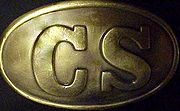
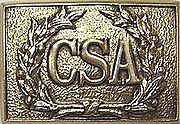
Belt
There were numerous types of belts produced for the Confederate Military during the Civil WarAmerican Civil War
The American Civil War was a civil war fought in the United States of America. In response to the election of Abraham Lincoln as President of the United States, 11 southern slave states declared their secession from the United States and formed the Confederate States of America ; the other 25...
. There were two types of belts which were standard to all army personal. The CS, standing for Confederate States, and CSA belt, standing for Confederate States of America. The buckle themselves were made of brass and were produced in multiple plants in the South and throughout the World.. Whether the belt was one with a CS or CSA on the buckle depended on the location at which it was made and on the maker. Some Confederate soldiers were issued with, or otherwise obtained, belt buckles with insignias unique to the state they came from or served under the command of. At the beginning of the war, soldiers with experience in the U.S. Army could often be seen still wearing "US" belt buckles, as this would have been all that they had available. As supplies became more difficult to obtain near the end of the war, buckles captured from Union forces were also worn.
Cavalry Uniforms
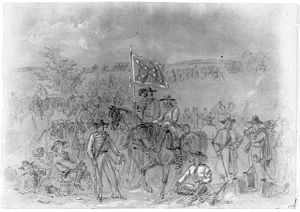
Design
The first of the Cavalry uniforms were made by the cavalrymen themselves. By 1862, the Confederate regulations ordered the uniform to become organized, being cadet greyCadet grey
Cadet grey is a shade of the color grey. The first recorded use of cadet grey as a color name in English was in 1912...
and lined with a thin layer around the sleeve. The pant legs were light blue with a yellow strip rising from the bottom of the leg to the top. Non-commissioned officers of the cavalry wore either regular clothes from home or a variety of different types of uniforms.
Buttons
A normal junior officer had two rows of evenly spaced seven buttons, grouped into pairs.Hats
The kepi was also standard issue to all army personnel. In the cavalry the color of the kepi was to be yellow. More common than the kepi was the Confederate stag hat, which was worn by most of the Confederate Cavalry.Design
The first of the Artillery uniforms were a variety of handmade and personally customized uniforms. By 1862, the Confederate uniforms became organized. They became cadet greyCadet grey
Cadet grey is a shade of the color grey. The first recorded use of cadet grey as a color name in English was in 1912...
and were to be lined with a layer of red around the sleeve. The pant legs were light blue. Even after the uniforms were organized many of the artillerymen wore regular clothes due to the heat and discomfort caused by the regular uniforms.
Buttons
In the Confederate Artillery a normal junior officer had two rows of seven evenly spaced buttons, grouped into pairs, while a senior officer could have as many as eight buttons in two rows.Hats
The kepi was also standard issue to the artillerymen, they were made red to match that of the rest of their uniforms. During the summer months they were also allowed to wear straw hats because of the heat.Design
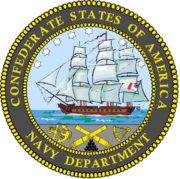
Serge
Serge is a type of twill fabric that has diagonal lines or ridges on both sides, made with a two-up, two-down weave. The worsted variety is used in making military uniforms, suits, great coats and trench coats. Its counterpart, silk serge, is used for linings. French serge is a softer, finer variety...
. They were also made in medium grey and cadet grey
Cadet grey
Cadet grey is a shade of the color grey. The first recorded use of cadet grey as a color name in English was in 1912...
. They were made of wool, and these uniforms were not fit for the heat of the lower decks of a ship. Non-commissioned officers wore a variety of uniforms, or even regular clothing.
| Insignia location | Admiral | Captain | Commander | Lieutenant | Master | Passed Midshipman | Midshipman |
|---|---|---|---|---|---|---|---|
| Sleeves |  |
 |
 |
 |
 |
 |
 |
| Shoulder Straps |
 |
 |
 |
 |
 |
 |
|
| Cover |  |
 |
 |
 |
 |
 |
 |
Shoulder Straps
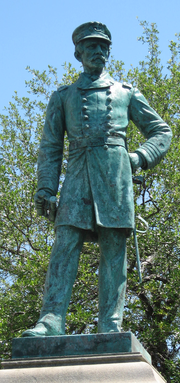
- Admirals wore a shoulder strap of sky-blue cloth, edged with black, that was four inches long and one inch and three-eighths wide embroidered with gold one-quarter of an inch in width. They had five stars spaced equally, the two on the ends six-tenths of an inch in diameter, and the three intermediate stars six-eighths of an inch in diameter.
- Flag officerFlag OfficerA flag officer is a commissioned officer in a nation's armed forces senior enough to be entitled to fly a flag to mark where the officer exercises command. The term usually refers to the senior officers in an English-speaking nation's navy, specifically those who hold any of the admiral ranks; in...
s wore a shoulder strap of sky-blue cloth, edged with black, that was four inches long and one inch and three-eighths wide embroidered with gold one-quarter of an inch in width. They had four stars spaced equally, the two on the ends six-tenths of an inch in diameter, and the two intermediate stars six-eighths of an inch in diameter. - captainCaptain (naval)Captain is the name most often given in English-speaking navies to the rank corresponding to command of the largest ships. The NATO rank code is OF-5, equivalent to an army full colonel....
s wore the same shoulder straps as the flag officers, but with three equally spaced stars, each six-tenths of an inch in diameter. - CommanderCommanderCommander is a naval rank which is also sometimes used as a military title depending on the individual customs of a given military service. Commander is also used as a rank or title in some organizations outside of the armed forces, particularly in police and law enforcement.-Commander as a naval...
s also had the same shoulder straps, but with only two stars. - LieutenantLieutenantA lieutenant is a junior commissioned officer in many nations' armed forces. Typically, the rank of lieutenant in naval usage, while still a junior officer rank, is senior to the army rank...
s had the same shoulder straps, with a single, central, star. - The shoulder straps worn by masters had the same design, but without any stars.
- Passed midshipmenMidshipmanA midshipman is an officer cadet, or a commissioned officer of the lowest rank, in the Royal Navy, United States Navy, and many Commonwealth navies. Commonwealth countries which use the rank include Australia, New Zealand, South Africa, India, Pakistan, Singapore, Sri Lanka and Kenya...
wore a strip of gold lace four inches in length and a half an inch wide. - For a midshipmanMidshipmanA midshipman is an officer cadet, or a commissioned officer of the lowest rank, in the Royal Navy, United States Navy, and many Commonwealth navies. Commonwealth countries which use the rank include Australia, New Zealand, South Africa, India, Pakistan, Singapore, Sri Lanka and Kenya...
, no shoulder straps were to be worn.
Caps
Confederate Naval Caps were made of steel grey cloth. They were not to be less than three inches and a half, nor more than four inches in height. They were also not to be more than ten, or less than nine inches and a half, at the top, and had a patent leather visor, to be worn by all officers in their service dress.- For a flag officer, the cap had an anchor in an open wreath of oak leaves, with four stars above the anchor. They were to be embroidered in gold as per pattern.
- For a captain, the same as a flag officer's, except that there were only three stars above the anchor, and the gold band was one and one-half inches wide.
- For a commander it was to be the same as for a captain, except that there were only but two stars.
- For a lieutenant, the same as that of a captain, except there was only one star.
- For a master, the same as for a captain, except that there was no star.
- For a passed midshipman, an anchor without a wreath.
- For a midshipman, no caps were to be worn.
Confederate States Marine Corps uniforms
The uniform used by the Confederate States Marine CorpsConfederate States Marine Corps
The Confederate States Marine Corps , a branch of the Confederate States Navy, was established by an act of the Congress of the Confederate States on March 16, 1861. The CSMC's manpower was initially authorized at 45 officers and 944 enlisted men, and was increased on September 24, 1862 to 1026...
resembled that prescribed for the Confederate Army. However, there is controversy about some of the exact details of the uniform, since the CSMC was not as large, and many of its records were destroyed. In 1865, right after the war's end, Lloyd J. Beall
Lloyd J. Beall
Lloyd James Beall was a United States Army officer and paymaster. During the American Civil War, he served as a colonel and as Commandant of the Confederate States Marine Corps...
, commander of the CSMC, had a fire at his home which destroyed most of the CSMC's records. It is clear, however, that the Marines were often equipped out of the stores of whichever garrison was nearest their location. One description has the Marines dressed in, frock coat
Frock coat
A frock coat is a man's coat characterised by knee-length skirts all around the base, popular during the Victorian and Edwardian periods. The double-breasted style is sometimes called a Prince Albert . The frock coat is a fitted, long-sleeved coat with a centre vent at the back, and some features...
s of a particular (and undetermined) shade of gray, and dark blue or black trousers. It appears that Confederate Marines wore forage cap
Forage cap
Forage cap is the designation given to various types of military undress, fatigue or working headresses. These varied widely in form, according to country or period...
s although it is unclear if there was any ornamentation on the cover. Much of the gear worn by the CSMC was imported from Russia
Russia
Russia or , officially known as both Russia and the Russian Federation , is a country in northern Eurasia. It is a federal semi-presidential republic, comprising 83 federal subjects...
, and from Great Britain
Great Britain
Great Britain or Britain is an island situated to the northwest of Continental Europe. It is the ninth largest island in the world, and the largest European island, as well as the largest of the British Isles...
and its empire
British Empire
The British Empire comprised the dominions, colonies, protectorates, mandates and other territories ruled or administered by the United Kingdom. It originated with the overseas colonies and trading posts established by England in the late 16th and early 17th centuries. At its height, it was the...
, mainly Canada
Canada
Canada is a North American country consisting of ten provinces and three territories. Located in the northern part of the continent, it extends from the Atlantic Ocean in the east to the Pacific Ocean in the west, and northward into the Arctic Ocean...
. This created a fairly unique look.
See also
- Military of the Confederate States of AmericaMilitary of the Confederate States of AmericaThe Military of the Confederate States of America comprised three branches:* Confederate States Army - The Confederate States Army the land-based military operations...
- United States Civil War
- Confederate States ArmyConfederate States ArmyThe Confederate States Army was the army of the Confederate States of America while the Confederacy existed during the American Civil War. On February 8, 1861, delegates from the seven Deep South states which had already declared their secession from the United States of America adopted the...
- Confederate States NavyConfederate States NavyThe Confederate States Navy was the naval branch of the Confederate States armed forces established by an act of the Confederate Congress on February 21, 1861. It was responsible for Confederate naval operations during the American Civil War...
- Confederate States Marine CorpsConfederate States Marine CorpsThe Confederate States Marine Corps , a branch of the Confederate States Navy, was established by an act of the Congress of the Confederate States on March 16, 1861. The CSMC's manpower was initially authorized at 45 officers and 944 enlisted men, and was increased on September 24, 1862 to 1026...
- Uniform of the Union ArmyUniform of the Union ArmyThe Uniform of the Union Army was widely varied and, due to limitations on supply of wool and other materials, based on availability and cost of materials during the United States Civil War.- Generalization :The standard U.S...

